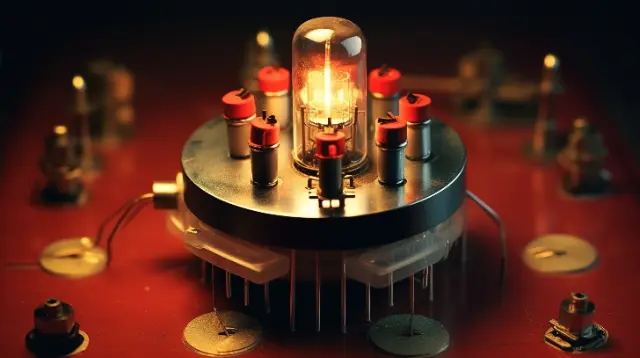What is the difference between punch-through and non-punch-through diodes?

In this article, I will talk about the concept of power diodes and elaborate on the key differences between punch-through diodes and non punch-through diodes. Let’s start with the basics, shall we?
Understanding Diodes
The world of semiconductors is vast, and diodes, in particular, are fascinating devices that serve as an integral part of this universe.
Understanding the nuances of different types of diodes, such as punch-through and non-punch-through diodes, can provide significant insight into the functioning and potential applications of these devices.
In this article, we will delve deep into the concept of diodes, the peculiarities of power diodes, and the distinct differences between punch-through and non-punch-through diodes.
The Basics: What are Diodes?
At the most fundamental level, a diode is an electronic component that allows electric current to flow primarily in one direction, thereby exhibiting a kind of electrical "one-way street."
It comprises two terminals known as the anode (positive terminal) and the cathode (negative terminal).
The core mechanism of a diode's function is rooted in the interaction between the N-type and P-type semiconductor materials.
The former contains excess electrons (negative charge carriers), and the latter contains excess holes (positive charge carriers). When these two materials are joined together, a 'PN junction' forms, leading to a 'depletion region,' which acts as a barrier to charge carriers.
This barrier or junction prevents the current from flowing in the reverse direction, hence defining the diode's characteristic unidirectional current flow.
Power Diodes: A Specific Class
Power diodes are a specific class of diodes that are designed to handle relatively high current and voltage levels. They are primarily used in power conversion and voltage regulation applications, such as in inverters, power supplies, or motor drives.
A power diode's design aims to minimize factors such as forward voltage drop and reverse recovery time while maximizing the diode's ability to withstand high voltages and currents without damage or degradation.
The particularities of power diodes come down to factors such as their material composition, the junction's characteristics, and the overall device design.
Punch-Through vs. Non-Punch-Through Diodes
Among the range of power diodes, punch-through and non-punch-through diodes represent two distinctive design strategies. Their differences primarily arise from the structure of their PN junction and how they behave under high-voltage conditions.
Punch-Through Diodes: These diodes feature a lightly doped N layer (N-) between the heavily doped P+ and N+ layers. Under normal conditions, the N- layer provides a wide depletion region, which allows the diode to withstand high reverse bias voltages. However, when the reverse bias exceeds a certain limit, the depletion region expands so much that it "punches through" the N- layer, hence the name. This punch-through condition corresponds to the diode's breakdown voltage, beyond which it cannot block the reverse current.
Non-Punch-Through Diodes: In contrast, non-punch-through (NPT) diodes do not have the lightly doped N- layer. Instead, they rely on a heavily doped N+ layer adjoining the P+ layer. Because there's no N- layer, the punch-through effect cannot occur. Instead, under high reverse bias, the junction's electric field extends into the bulk of the N+ layer. This results in a relatively lower breakdown voltage compared to punch-through diodes.
The differences between these two types of diodes can be summarized as follows:
Breakdown Voltage: Punch-through diodes typically have a higher breakdown voltage than non-punch-through diodes because of their lightly doped N- layer that provides a wider depletion region.
Reverse Recovery Time: Punch-through diodes generally have a faster reverse recovery time compared to non-punch-through diodes. This is due to the N- layer's presence, which allows the diode to respond more quickly to changes in bias.
Forward Voltage Drop: Non-punch-through diodes typically have a lower forward voltage drop than punch-through diodes because of the absence of the N- layer.
Robustness: Non-punch-through diodes are generally more robust than punch-through diodes. They have a lower likelihood of experiencing catastrophic failure under high stress conditions, primarily due to their heavy doping levels.
Applications: Due to their unique characteristics, punch-through diodes are often used in high-voltage, low-frequency applications, while non-punch-through diodes are more suited for lower voltage, high-frequency applications.
In conclusion, while both punch-through and non-punch-through diodes find extensive use in various applications, their design and performance characteristics define their suitability for specific conditions.
I hope this helps you understand the differences between these two types of diodes. Let me know if you have further questions on this topic.
Replies
-
 yogi.bharadwajConventional punch-through diode with highly doped base-collector junction active area of the punch-through diodes presented in this work, in which the conventional n+ emitter has been replaced by alternating negative and positive regions conduction band profile as a function of applied bias. Increasing the collector bias results in a depletion of the base region until eventually the base will become fully depleted. Further increasing the bias will result in a sudden increase in current corresponding field profile.
yogi.bharadwajConventional punch-through diode with highly doped base-collector junction active area of the punch-through diodes presented in this work, in which the conventional n+ emitter has been replaced by alternating negative and positive regions conduction band profile as a function of applied bias. Increasing the collector bias results in a depletion of the base region until eventually the base will become fully depleted. Further increasing the bias will result in a sudden increase in current corresponding field profile.
and non conventional are the simple diodes so punch through diodes are more useful with greater efficiency. -
 Manju Gowda
Manju GowdaDifference between punch through diode and non punch through diodes
You are reading an archived discussion.
